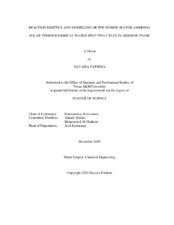| dc.description.abstract | The Hybrid Sulfur Ammonia Solar Thermochemical Water splitting cycle (HySA TCWSC) had proven to successfully split water to produce Hydrogen, the renewable source of energy. However, the process was found to be energy intensive in nature and the amount of molten salts produced by the conventional method were difficult to discard. Therefore, the possibility of the reaction being carried out in the aerosol phase rather than in molten state was considered as the aerosol reactor would require minimal amount of reactants to produce products. The behavior of the particles was studied. Therefore, a closer look at the reactions on particle level was considered. A mixture of ammonium sulfate (AS) and potassium sulfate (KS) was used for the reactions. The ratios 1 mol AS:0 mol KS, 1 mol AS:1 mol KS (stoichiometric ratio), 1 mol AS:2 mol KS were tested. The system was modelled using the heat transfer, mass transfer and reaction effects on the particle of AS in presence of KS. In order to model the particle, the reactions were confirmed using mass spectrometer (MS), Fourier Transformation Infrared (FT-IR) gas analyzer and Thermogravimetric Analysis (TGA) results for thermal decomposition of the prepared samples. Four reactions were concluded, and its kinetics were found using iso-conversional method. The first reaction was AS decomposition to ammonium pyrosulfate (APS), water (H2O) and ammonia (NH3). The reaction was of order 1.1 with activation energy 77 kJ/mol. The second reaction was APS conversion to NH3, sulfur trioxide (SO3) and H2O in absence of KS. The reaction was of order 0.8 with activation energy of 102 kJ/mol. The third reaction was APS decomposition in presence of KS which converted to potassium pyrosulfate (KPS). The reaction was of order 1.4 with activation energy 107 kJ/mol. Finally, the decomposition of KPS to KS and SO3 took place which had order of reaction, 0.8 and activation energy 110 kJ/mol. The sample did not show much variation for small changes introduced. However, the increase in KS ratio delayed SO3 produced and distinctly differentiated the NH3 and SO3 producing regions. | en |


